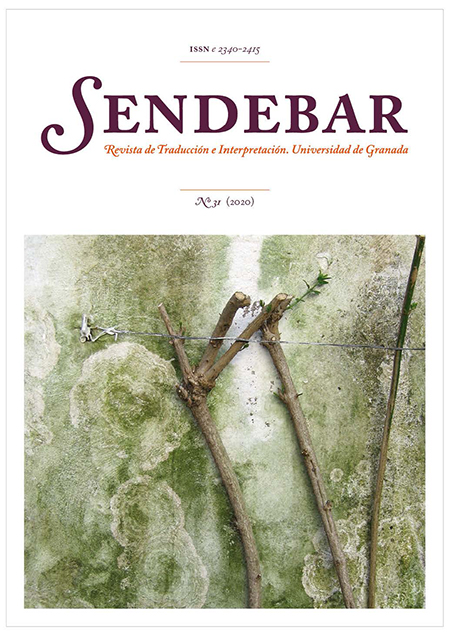Retraso y velocidades de lectura en la subtitulación para personas sordas de los informativos
DOI:
https://doi.org/10.30827/sendebar.v31i0.11836Palabras clave:
SPS, subtitulación en directo, accesibilidad, velocidad de lectura, informativosResumen
Este artículo surge de ITACA (Inclusión social, Traducción Audiovisual y Comunicación Audiovisual1), un proyecto de investigación interuniversitario e interdisciplinar sobre producción audiovisual accesible que pretende mejorar el acceso de las personas con limitaciones sensoriales a los medios audiovisuales. El estudio descriptivo que aquí presentamos se centra en la subtitulación para sordos (SPS) de los informativos, que suele elaborarse en directo o semidirecto. A tal fin, se seleccionaron once fragmentos de noticiarios emitidos en distintas cadenas públicas y privadas de televisión españolas. El retraso y la velocidad de lectura de los subtítulos, dos de los parámetros habituales para el análisis de la SPS, son la base de las hipótesis de trabajo y del marco analítico, cuyo objetivo es evaluar la SPS de los informativos desde una doble perspectiva, traductológica y fílmica. En líneas generales, los resultados muestran mayor retraso y menor velocidad de lectura en los subtítulos en directo respecto de los emitidos en semidirecto, lo que puede influir en la recepción por parte de los destinatarios finales.
Descargas
Citas
AENOR (2012). Norma UNE: 153010. Subtitulado para personas sordas y personas con discapacidad auditiva. Madrid: AENOR.
Casado Ruiz, Antonio (2011). La realización de programas informativos de televisión. En Periodismo en televisión. Nuevos horizontes, nuevas tendencias. Andreu Casero Ripollés y Javier Marzal Felici (eds.), 104-121. Zamora: Comunicación Social.
Comisión Nacional de los Mercados y la Competencia (CNMC) (2019). Informe sobre el seguimiento de las obligaciones impuestas en materia de accesibilidad correspondiente al año 2017. INF/DTSA/083/18 [en línea]. 30 de enero. <https://www.cnmc.es/sites/default/files/2311204_8.pdf> [Consulta: 15 enero 2020].
González-Iglesias González, J. David (2012). Desarrollo de una herramienta de análisis de los parámetros técnicos de los subtítulos y estudio diacrónico de series estadounidenses de televisión en DVD. Tesis doctoral, Universidad de Salamanca.
Gutiérrez Lanza, Camino (2007). Traducción inglés-español y censura de textos cinematográficos: Definición, construcción y análisis del Corpus 0/Catálogo TRACEci (1951-1981). En Traducción y censura en España (1939-1985). Estudios sobre corpus TRACE: Cine, narrativa, teatro. Merino, Raquel (ed.), 197-240. Bilbao: Universidad del País Vasco.
Díaz Arias, Rafael (2011). Vectores del infoentretenimiento en los noticieros de televisión. En Periodismo en televisión. Nuevos horizontes, nuevas tendencias. Andreu Casero Ripollés y Javier Marzal Felici (eds.), 61-83. Zamora: Comunicación Social.
Díaz Cintas, Jorge y Remael, Aline (2007). Audiovisual Translation: Subtitling. (Translation Practices Explained). Manchester: St. Jerome Publishing.
Díaz Cintas, Jorge; Orero, Pilar y Remael, Aline (eds.) (2007). Media for All: Subtitling for the Deaf, Audio Description, and Sign Language. Ámsterdam: Rodopi.
Díaz-Cintas, Jorge (2010). La accesibilidad a los medios de comunicación audiovisual a través del subtitulado y de la audiodescripción. En El español, lengua de traducción para la cooperación y el diálogo. Luis González y Pollux Hernúñez (eds.). Instituto Cervantes.
Ivarsson, Jan y Carroll, Mary (1998). Subtitling. Simrishamn: TransEdit HB.
Marín, Carles (2017). El informativo de televisión. Gedisa: Barcelona.
Martí Ferriol, José Luis (2019). El proceso de pautado, la sincronización y la velocidad de lectura. En La traducción para la subtitulación en España. Mapa de convenciones. Gloria Torralba Miralles, Ana Tamayo Masero, Laura Mejías-Climent, Juan José Martínez Sierra, José Luis Martí Ferriol, Ximo Granell, Julio de los Reyes Lozano, Irene de Higes Andino, Frederic Chaume y Beatriz Cerezo Merchán (eds.), 135-146. Castellón: Publicacions de la Universitat Jaume I.
Matamala, Anna y Orero, Pilar (2008). L’accessibilitat a TVC. Quaderns, 16, 301-312.
Matamala, Anna y Orero, Pilar (eds.) (2010). Listening to subtitles: subtitles for the deaf and hard of hearing. Berna: Peter Lang.
Neves, Josèlia (2008). 10 fallacies about Subtitling for the d/Deaf and the hard of hearing. The Journal of Specialised Translation, 10, 128-143.
Neves, Josèlia (2018). Subtitling for the deaf and hard of hearing audiences. En The Routledge Handbook of Audiovisual Translation. Luis Pérez-González (ed.), 82-95. Londres: Routledge.
Orero, Pilar; Pereira, Ana María y Utray, Francisco (2007). Visión histórica de la accesibilidad en los medios en España». TRANS. Revista de Traductología, 11, 32-43.
Romero-Fresco, Pablo (2009). More haste less speed: edited and verbatim respoken subtitles. Vigo International Journal of Applied Linguistics (VIAL) 6, 109-133. <http://vialjournal.webs.uvigo.es/pdf/Vial-2009-Article6.pdf> [Consulta: 15 enero 2020].
Romero-Fresco, Pablo (2011). Subtitling through speech recognition: Respeaking. Ámsterdam: Routledge.
Romero-Fresco, Pablo (2013). Accessible filmmaking: Joining the dots between audiovisual translation, accessibility and filmmaking. The Journal of Specialised Translation 20, 201-223. <http://www.jostrans.org/issue20/art_romero.php> [Consulta: 15 enero 2020].
Romero-Fresco, Pablo (ed.) (2015). The Reception of subtitles for the deaf and hard of hearing in Europe. Berna: Peter Lang.
Romero-Fresco, Pablo (2018). Respeaking. Subtitling through speech recognition. En The Routledge Handbook of Audiovisual Translation. Luis Pérez-González (ed.), 96-113. Londres: Routledge.
Romero-Fresco, Pablo y Martínez, Juan (2015). Accuracy Rate in Live Subtitling – the NER Model. En Audiovisual Translation in a Global Context. Baños Piñero, Rocío y Díaz Cintas, Jorge (eds.), 28-50. Londres: Palgrave Macmillan.
Tamayo, Ana (2015). Estudio descriptivo y experimental de la traducción en TV para niños sordos. Una propuesta alternativa. Tesis doctoral, Universitat Jaume I.
Zárate, Soledad y Eliahoo, Joseph (2014). Word recognition and content comprehension of subtitles for television by deaf children. The Journal of Specialised Translation 21, 133-152. <http://www.jostrans.org/issue21/art_zarate.php> [Consulta: 15 enero 2020].
Descargas
Publicado
Cómo citar
Número
Sección
Licencia
Terminos de Licencia Sendebar.

















